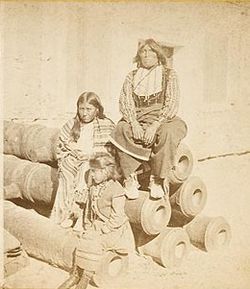| Buffalo Hunter's War | |||||||
|---|---|---|---|---|---|---|---|
| Part of the Texas–Indian wars, Apache Wars | |||||||
 Black Horse with his wife and child at Fort Marion, Florida. | |||||||
| |||||||
| Commanders and leaders | |||||||
| Hank Campbell - Buffalo hunters | Black Horse - Comanche | ||||||
The Buffalo Hunters' War, or the Staked Plains War, occurred in 1877. Approximately 170 Comanche warriors and their families led by Quohadi chief Black Horse or Tu-ukumah (unknown–ca. 1900) left the Indian Territory in December, 1876, for the Llano Estacado of Texas. In February, 1877, they, and their Apache allies, began attacking buffalo hunters' camps in the Red River country of the Texas Panhandle, killing or wounding several. They also stole horses from the camp of Pat Garrett.[citation needed]
Forty-five hunters, led by Hank Campbell, Jim Smith, and Joe Freed, and guided by Jose Tafoya, left Rath City, a trading post on the Double Mountain Fork Brazos River. Smoky Hill Thompson remained behind to lead the defense of the trading post.[citation needed]
The party trailed the natives to their camp in Thompson's Canyon, now known as Yellow House Canyon in present-day Lubbock, Texas, where they attacked on March 18. The hunters were repulsed and the natives escaped, including white captive Herman Lehmann, who was wounded in the battle.[citation needed]
The hunters' casualties were four wounded and one later dying from wounds. It was later reported by the military that the natives suffered 35 dead and 22 wounded.[citation needed]
See also[edit]
References[edit]
- Dictionary of American History by James Truslow Adams, New York: Charles Scribner's Sons, 1940
- The Border and the Buffalo by John R. Cook, 1907, Citadel Press (1967)
- Black Horse from the Handbook of Texas Online
- Battle of Yellow House Canyon from the Handbook of Texas Online
- In 1877, Mackenzie Park was site of a deadly battle. Lubbock Online, Nov. 27, 2007
Well, that’s interesting to know that Psilotum nudum are known as whisk ferns. Psilotum nudum is the commoner species of the two. While the P. flaccidum is a rare species and is found in the tropical islands. Both the species are usually epiphytic in habit and grow upon tree ferns. These species may also be terrestrial and grow in humus or in the crevices of the rocks.
View the detailed Guide of Psilotum nudum: Detailed Study Of Psilotum Nudum (Whisk Fern), Classification, Anatomy, Reproduction